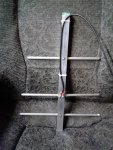Below is, yet another, DIY antenna. It's a 3 element
beam.
This antenna is still in the design phase and this is
my prototype. When I finished, I put it to a short test
with SWR meter. Then I did a short test with a CCR
handheld. I got a pretty good SWR and I was able to,
once again, open repeaters that I cannot open with the
rubber ducky, nor a Nagoya 19" telescoping antenna. I
get some good " S meter reports" from friends. My SWR
on both my Motorola and the CCR is 1.5:1 average.
(I have a friend bringing over an antenna analyzer when
he can)
I'm looking for input for a possible matching stub plus the following:
1) Do I need one?
a) Would you be happy with a 1.4:1 on your Motorola?
2) Do I have to put the stub on both the center conductor and the shield or just the center?
3) Even though it's all I have, is 20' off the ground enough?
4) Most important. How do I figure out what the gain is of this antenna?
beam.
This antenna is still in the design phase and this is
my prototype. When I finished, I put it to a short test
with SWR meter. Then I did a short test with a CCR
handheld. I got a pretty good SWR and I was able to,
once again, open repeaters that I cannot open with the
rubber ducky, nor a Nagoya 19" telescoping antenna. I
get some good " S meter reports" from friends. My SWR
on both my Motorola and the CCR is 1.5:1 average.
(I have a friend bringing over an antenna analyzer when
he can)
I'm looking for input for a possible matching stub plus the following:
1) Do I need one?
a) Would you be happy with a 1.4:1 on your Motorola?
2) Do I have to put the stub on both the center conductor and the shield or just the center?
3) Even though it's all I have, is 20' off the ground enough?
4) Most important. How do I figure out what the gain is of this antenna?


